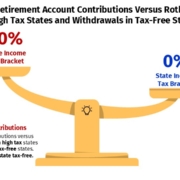Maximize Roth 401(k) And Roth IRA Contributions on a Modest Income

Money Matters – Skloff Financial Group Question of the Month – May 1, 2018
By Aaron Skloff, AIF, CFA, MBA
Q: We both earn modest incomes but want to maximize our Roth 401(k) and Roth IRA contributions. Can we contribute to a Roth 401(k) and Roth IRA in the same year? If so, can our combined contributions exceed our take-home pay?
The Problem – Maximizing Roth 401(k) and Roth IRA Contributions on a Modest Income
Tax advantages always seem to favor the wealthy, leaving those with modest incomes behind.
The Solution – Maximizing Roth 401(k) and Roth IRA Contributions, Using Tax Laws That Favor Those with Modest Incomes
You can make contributions to a 401(k) plan (or 403(b) or 457(b) plan) on pre-tax or Roth basis (and after-tax basis in addition to a Roth on a 401(k) or 403(b) plan if the plan allows). This article focuses on the differences between pre-tax contributions and Roth contributions, with an emphasis on the latter. It also focuses on maximizing Roth 401(k) and Roth IRA contributions in the same year, in excess of take-home pay.
Are You Interested in Learning More?
Pre-Tax 401(k) Versus Roth 401(k) Contributions. Until the Roth 401(k) was introduced, you could contribute to your 401(k) on a pre-tax basis. By doing so, you gained an immediate tax break. Taxes on contributions and gains on those contributions were deferred until they were withdrawn in retirement. The higher your tax bracket, the more valuable the tax break. With the introduction of the Roth 401(k), all eligible employees could contribute to your 401(k) on an after-tax basis. By doing so, you forego tax breaks today so all withdrawals of principal and gains in retirement are tax-free. The higher your future tax bracket, the more valuable foregoing today’s tax break. Roth 401(k) annual contributions limits are $18,500 for those under the age of 50 and $24,500 for those 50 and over. Your (separate from employer) contributions cannot exceed your after-tax (i.e.: federal and state income taxes, Social Security, etc.) compensation – “take-home pay”.
Pre-Tax Traditional IRA Versus Roth IRA Contributions. Until the Roth IRA was introduced, you could contribute to your Traditional IRA on a pre-tax basis. The tax advantages are similar to pre-tax 401(k) contributions. With the introduction of the Roth IRA, you could contribute on an after-tax basis. The tax advantages are similar to Roth 401(k) contributions. Roth IRA annual contributions limits are $5,500 for those under the age of 50 and $6,500 for those 50 and over. You begin to lose your ability to contribute to a Roth IRA if your income exceeds $120,000 for single filers or $189,000 for those married filing jointly.
Maximizing Roth 401(k) and Roth IRA Contributions, Using Tax Laws That Favor Those with Modest Incomes Examples. Those with a modest income gain an advantage over high earners (who’s income can preclude them from maximizing both Roth 401(k) and Roth IRA contributions). According to the Internal Revenue Code, Roth IRA contributions cannot exceed $5,500 ($6,500 if age 50 or older) or “your taxable compensation for the year, if your compensation was less than this dollar limit”. Translation: You can still contribute to a Roth IRA even if your take-home pay is $0 because contributions are based on “taxable compensation”. This shifts taxable savings to tax free savings.
Let’s look at the chart below. The couple on the left (under age 50) each earn a modest $22,000 of taxable compensation. After taxes of $3,400, their take home-pay before Roth 401(k) contributions was $18,600. They each contribute $18,500 to their Roth 401(k)s – maximizing contributions. This leaves them with a net $100 of take-home pay. Despite $100 of net take-home pay, they use personal savings to each contribute $5,500 to their Roth IRAs (based on their taxable compensation). This results in $24,000 in total contributions for each. The couple on the right (50 years old) each earn a modest $30,000 of taxable compensation. After taxes of $5,000, their take home-pay before Roth 401(k) contributions was $25,000. They each contribute $24,500 to their Roth 401(k)s – maximizing contributions. This leaves them with a net $500 of take-home pay. Despite $500 of net take-home pay, they use personal savings to each contribute $6,500 to their Roth IRAs (based on their taxable compensation). This results in $31,000 in total contributions for each.
Click to Enlarge
Action Steps – Maximize Roth 401(k) and Roth IRA Contributions on a Modest Income
Despite earning a modest income, contribute aggressively to Roth retirement vehicles to create a healthy tax-free retirement nest egg.
Aaron Skloff, Accredited Investment Fiduciary (AIF), Chartered Financial Analyst (CFA), Master of Business Administration (MBA) is CEO of Skloff Financial Group, a Registered Investment Advisory firm specializing in financial planning, investment management and benefits for small to middle sized companies. He can be contacted at www.skloff.com or 908-464-3060.
Are You Interested in Learning More?














